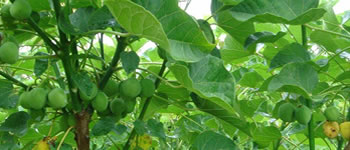|
|
 |
| 'From Seed to Tank' |
| System of scientific plantation
management and quality control - from instituting precise protocol
for soil preparation and planting, to utilizing state-of-the
art machinery |
|
|
|
|
| |
| |
|
| |
Agronomy |
| |
Jatropha Curcas |
| |
| |
Jatropha Curcas
Biodiesel is an alternative fuel derived from the fruits of
the jatropha curcas plant.
It can be used in compression ignition engines (diesel engines)
without any modifications. It refers to methyl esters derived
from jatropha oil through a process known as ‘transesterification’.
Biodiesel has been recognized and accepted as an alternative
and renewable source of energy which is environmentally friendly.
Biodiesel is degradable, non toxic and can be used in pure form
but is often blended with regular diesel. |
|
| |
|
|
Jatropha
curcas cultivation
Jatropha
curcas is a very hardy plant which exudes whitish latex when
cut.
It normally grows between 3 to 5 meters. It may produce several
crops during the year under favorable conditions.
|
|
Analysis of
the seed shows the following chemical composition:
Moisture 6.20 %
Protein 18.00 %
Fat 38.00 %
Carbohydrates 17.00 %
Fiber 15.5 %
Ash 5.30%
The oil content is 25-30% in the seeds and 50-60% in the kernel.
The oil contains 21% saturated fatty acids and 79% unsaturated
fatty acids. There are some chemical elements in the seed which
are poisonous and render the oil not suitable for human consumption. |
| |
|
|
Uses
of jatropha curcas
-make
soap
-use as illuminant
- as a medicinal plant example snake bite, clean teeth, cure
piles, etc..
- dark blue dye for clothing and nets
- leaves is a food for tusser silkworm
- fruits can be make into fertilizer (rich in nitrogen, phosphorous
and potassium
- used as insecticide
- biodiesel |
| |
|
|
What
do we offer?
VDHB shall commence planting of Jatropha Curcas on the plots of Concession Land obtained from the Cambodian Government. The bulk of Cambodia land is fairly flat, is vacant and without vegetation.
VDHB is also in the process of planting Jatropha Curcas in Malaysia, Indonesia, Philippines, China and Laos, using one of the four Agronomy model as described in clause 18.
VDHB shall carry out the following for the planting of Jatropha Curcas:
- Carry out Environment Impact Study to also determine the soil conditions, rainfall level and mapping of the land etc.
- Provide Civil Engineering Works including the construction of trunk roads across the Plantations.
- Provide Drainage System at appropriate terrain to unlock water clogging.
- Create Reservoirs to collect rain water and install a distribution of irrigation system.
- Provide Plantlets
- Start up Nurseries for mass propagation.
- Built living quarters for the Plantation Workers
|
|
| |
|
|
Benefits
to the host countries
The cultivation of Plantations together with the necessary machineries and equipment at each countries will cost many millions of US$ each. These investments is expected to bring about many benefits to the host countries which would include but not limited to:
- Productivity created at marginal, semi-arid and waste land which otherwise would be left vacant.
- Create mass employment and increase earnings for the local villagers.
- Spin-off supporting industries, including logistics, shipping, mechanical and electrical works, road works, housing, maintenance support, etc.
- Foreign Exchange revenue.
With the above possible contributions, VDHB has received a lot of positive and welcome gestures from high level Government Officials in the regional countries where discussions and negotiations were held.
|
| |
|
|
|
|

